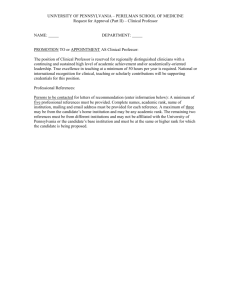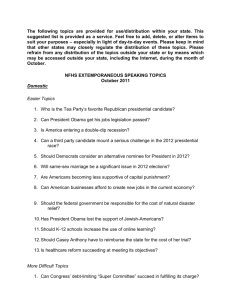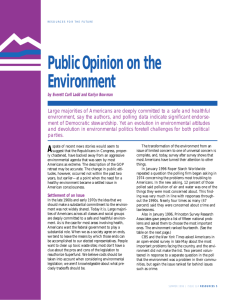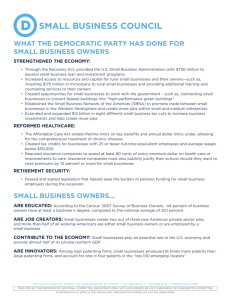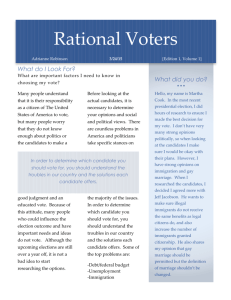Senate PAAR: 2016 Preview DATE: September 15, 2015
advertisement
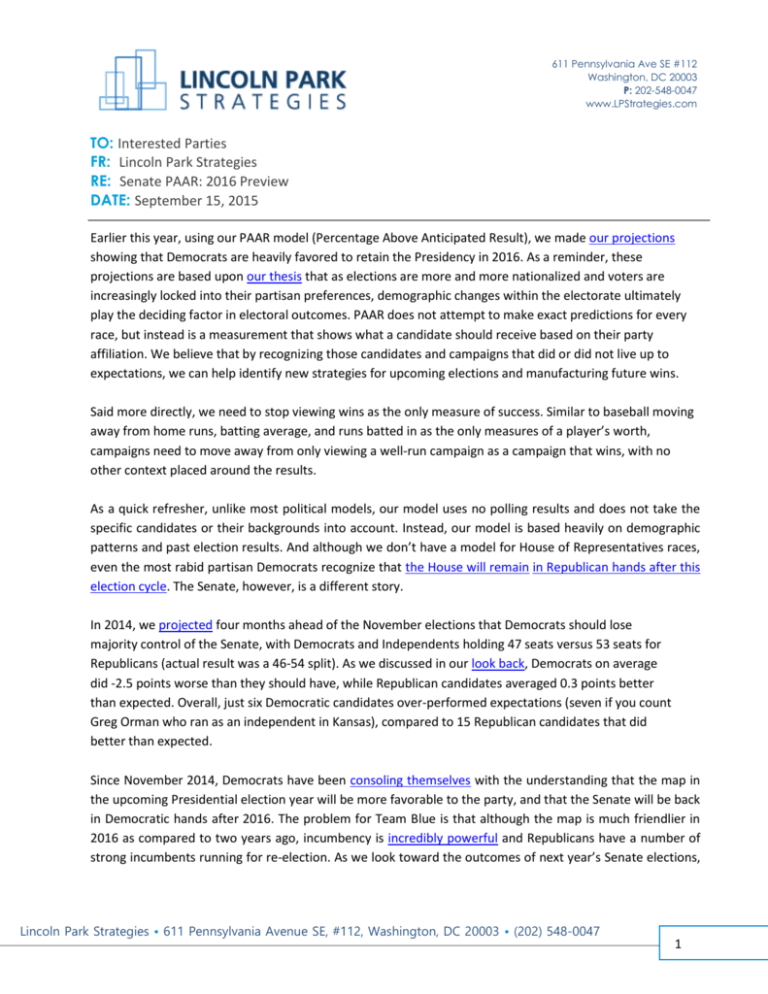
611 Pennsylvania Ave SE #112 Washington, DC 20003 P: 202-548-0047 www.LPStrategies.com TO: Interested Parties FR: Lincoln Park Strategies RE: Senate PAAR: 2016 Preview DATE: September 15, 2015 Earlier this year, using our PAAR model (Percentage Above Anticipated Result), we made our projections showing that Democrats are heavily favored to retain the Presidency in 2016. As a reminder, these projections are based upon our thesis that as elections are more and more nationalized and voters are increasingly locked into their partisan preferences, demographic changes within the electorate ultimately play the deciding factor in electoral outcomes. PAAR does not attempt to make exact predictions for every race, but instead is a measurement that shows what a candidate should receive based on their party affiliation. We believe that by recognizing those candidates and campaigns that did or did not live up to expectations, we can help identify new strategies for upcoming elections and manufacturing future wins. Said more directly, we need to stop viewing wins as the only measure of success. Similar to baseball moving away from home runs, batting average, and runs batted in as the only measures of a player’s worth, campaigns need to move away from only viewing a well-run campaign as a campaign that wins, with no other context placed around the results. As a quick refresher, unlike most political models, our model uses no polling results and does not take the specific candidates or their backgrounds into account. Instead, our model is based heavily on demographic patterns and past election results. And although we don’t have a model for House of Representatives races, even the most rabid partisan Democrats recognize that the House will remain in Republican hands after this election cycle. The Senate, however, is a different story. In 2014, we projected four months ahead of the November elections that Democrats should lose majority control of the Senate, with Democrats and Independents holding 47 seats versus 53 seats for Republicans (actual result was a 46-54 split). As we discussed in our look back, Democrats on average did -2.5 points worse than they should have, while Republican candidates averaged 0.3 points better than expected. Overall, just six Democratic candidates over-performed expectations (seven if you count Greg Orman who ran as an independent in Kansas), compared to 15 Republican candidates that did better than expected. Since November 2014, Democrats have been consoling themselves with the understanding that the map in the upcoming Presidential election year will be more favorable to the party, and that the Senate will be back in Democratic hands after 2016. The problem for Team Blue is that although the map is much friendlier in 2016 as compared to two years ago, incumbency is incredibly powerful and Republicans have a number of strong incumbents running for re-election. As we look toward the outcomes of next year’s Senate elections, Lincoln Park Strategies • 611 Pennsylvania Avenue SE, #112, Washington, DC 20003 • (202) 548-0047 1 our PAAR model projects that Democrats will likely come up just short with 49 seats, although the races in Florida and Ohio should be razor thin, and neither side is viewed as having a lock on winning the majority. WHERE PUNDITS AND PARTISANS ARE WRONG Every election season, certain races get touted as dark horse seats that the political parties plan to use to expand their maps. Nonetheless, these races almost never end up being close. For every Heidi Heitkamp, there are dozens of Carly Fiorinas, Alison Lundergan Grimes, Michelle Nunns, etc. and 2016 will certainly have its share of these races as well. For example, Politico recently published a ranking of 15 close Senate races for 2016. While 15 is an expansive number for the article to discuss, the piece should have capped it at eight, as the last seven are pretty unlikely to occur. Among the competitive races ranked 9th to 15th, Alaska, Arizona, Georgia, and Kentucky all have incumbents in deeply red states. And while Georgia is trending toward purple, it has a long way to go before it’s truly competitive, with PAAR projecting the race at 56.3 to 41.6 in favor of Team Red. Additionally, PAAR likes Richard Burr’s chances to cruise to easy re-election in North Carolina, and puts Michael Bennet at a relatively easy 6-percentage point win in Colorado. Overall this is what the landscape looks like according to our model: REPUBLICAN HELD SEATS Democratic Candidate Favored by 10 points or more Illinois (+15.7) Democratic Candidate Favored by 5-9.9 points Republican Democratic Candidate Candidate Less than 5 Favored by less Republican Republican Favored by points and than 5 points Candidate Candidate less than 5 neither party and GOP Favored by Favored by 10 points above 50% above 50% 5-9.9 points points or more Wisconsin (+4.4) Florida Missouri (+3.3) Indiana (+5.8) 15 Seats (R +1.5) Pennsylvania Ohio (R +1.7) New North Carolina (+4.6) Hampshire (+8.1) (+3.3) Lincoln Park Strategies • 611 Pennsylvania Avenue SE, #112, Washington, DC 20003 • (202) 548-0047 2 DEMOCRATIC HELD SEATS Democratic Candidate Favored by 10 points or more 8 Seats Democratic Candidate Favored by 5-9.9 points Colorado (+6.0) Nevada (+7.3)* Democratic Candidate Favored by less than 5 points Republican Candidate Less than 5 Favored by less points and than 5 points neither party and GOP above 50% above 50% Republican Candidate Favored by 5-9.9 points Republican Candidate Favored by 10 points or more *The Democratic candidate in NV is favored by over 7 points but the score is still below 50% To put these numbers in perspective, in 2014 only 10 races had candidates that were 5 points or more off from their PAAR score (8 on the positive side for Republicans and 2 on the positive for Democrats) and only half of these were contested elections. Said in another way, only 5 Senate elections in 2014 were both contested and the results were well above expectations. SEATS MOST LIKELY TO FLIP Based on the PAAR projections, there are three seats that are projected to switch hands in 2016, each from Republican to Democrat: Illinois, Pennsylvania, and Wisconsin. Let’s start with the man who is universally regarded as the most likely incumbent to lose in 2016, Mark Kirk in Illinois. Kirk has carved a reputation as moderate, but the demographics of Illinois in a presidential election are likely simply too much for him to overcome. His situation is virtually identical to what we identified for Mark Begich in Alaska in 2014. Begich, a moderate incumbent, was barely elected in a wave election for his party, in a state that heavily favored the other party. Just as Senator Begich ended up performing better than his PAAR projection, we expect Kirk to exceed his projections, but there is no precedence for overcoming Kirk’s PAAR gap of 15.7 points. In Pennsylvania, the PAAR model is more bullish about Democrats chances than many pundits are, putting a Democratic victory in the state at a margin of 51.8 to 47.2 percent. Additionally, PAAR views this race similarly to Illinois. Here, a Republican narrowly won in a Republican wave year, in a state that has consistently otherwise given Democrats statewide victories and assumes the Democrats will take back the seat. Until recently, Democrats struggled to recruit a candidate they liked for the race. However, with the entry of Katie McGinty, a Democratic primary against Joe Sestak is now in play to determine who will face off against Senator Pat Toomey. And while we don’t know yet who will win the nomination, the fact that Senator Toomey is now an incumbent after narrowly winning last time to Sestak leads the model to predict that this should not be enough to keep Senator Toomey in office. Finally, Wisconsin is rated nearly identical to Pennsylvania at 51.3 to 46.9 percent. However, unlike in Pennsylvania, Democrats in the Badger State have gotten what they wanted, a rematch of 2010. By drawing Lincoln Park Strategies • 611 Pennsylvania Avenue SE, #112, Washington, DC 20003 • (202) 548-0047 3 former Senator Russ Feingold back into the race, the model points to this being a tight race, but Democrats clearly have a very good chance of matching our projection and winning in Wisconsin. THE DECIDING STATES There are four races that PAAR projects to be within 3.5 percentage points: New Hampshire, Ohio, Florida, and Missouri. In the Granite State, Republican Kelly Ayotte is exactly the kind of swing state popular incumbent that will make this a very challenging pick-up for Democrats. Looking back, New Hampshire has gone to the Democrats in the last three statewide elections: the most recent Senate election and the last two gubernatorial elections. However, none of these victories have been by a large margin and New Hampshire is not a state where Democrats have been helped by demographic changes. Democrats will probably have to convince popular Governor Maggie Hassan to run, and even then it is far from an assured victory. Our model points to a GOP victory by a 50.4 to 47.1 margin. In Ohio, Rob Portman may be even tougher than Ayotte to knock off for very similar reasons. Portman has crafted a more moderate image in the state and has shown to be a prolific fundraiser. Given that we are predicting Ohio to be the second most important state in the Presidential and Senate elections, it is a safe bet that Ohioans will be bombarded by campaigns on all fronts for the next 14 months. The intensity of the focus of both races could cut either way. Portman’s popularity could help the Republican presidential nominee, or Hillary Clinton’s coattails may be enough to sink Portman in a close race. PAAR gives the GOP candidate a slight edge at 49.5 to 47.8, but clearly neither party is viewed as starting this race with a likelihood of attaining a majority level of support. The closest projected race in PAAR’s estimation is in Florida, with a spread of just 1.5 percentage points separating the candidates. This is assuming Marco Rubio will abide by his pledge to not run for the seat should he lose the Republican nomination for President. If Rubio were to run for re-election, this would be a considerably safer seat for Republicans (this is not a judgement on him as a candidate, but the power of incumbency). The recent dominance of Republicans all across the state gives the party a very deep bench of candidates to select from. For Democrats, the race appears to be down to Representatives Alan Grayson and Patrick Murphy. The chances of Democrats winning the seat and getting to a 50-50 Senate split are higher with Murphy than Grayson, but the race will likely be very close no matter who ends up with the nomination. PAAR gives the Republican candidate a slight edge (46.3 compared to 44.8), and also points to the true swing nature of the Sunshine State given the relatively low PAAR rating for both candidates. While PAAR has proven to be very accurate in most states, there are two Senate projections that are unlikely to occur. As we noted in our 2016 Presidential preview, the PAAR model is most likely overstating Democrats’ Lincoln Park Strategies • 611 Pennsylvania Avenue SE, #112, Washington, DC 20003 • (202) 548-0047 4 chances in Missouri. The combination of Obama’s strong performance in 2008 and Todd Akin’s implosion in 2012 make the model assume that Missouri is far more of a toss-up state than it actually is. Although Democrats were able to recruit their top candidate, it’s very hard to imagine Missouri ending up as the thirdclosest Senate race in 2016. Much like Missouri, PAAR is also likely overstating Democrats chances in Indiana. Again, Democrats are buoyed by Barack Obama’s unlikely win in the state in 2008 and by Richard Mourdock’s 2012 debacle running for Senate. It is hard to fathom that this race will turn out as PAAR projects and be closer than say Nevada. Which brings us to the interesting case of the Silver State. The Democratic candidate is favored by 7.3 points, however, the PAAR model prediction puts the Democratic candidate just under the 50 percent threshold (49.4). Senator Harry Reid had a close race in 2010, but his previous elections we less in question. Additionally, although the lack of an incumbent is lowering the chances for Democrats, the Republican candidate will have to run a near perfect race to make up for the 7 point deficit we are predicting they will start with. IMPLICATIONS Control of the Senate in 2016 projects to be much closer than either the Presidency or the House. Since Republicans only need to over perform in one race, the Presidency, to get unified control of the federal government once again, Democrats must not take the Senate lightly and should not expect to be handed the majority simply because of a favorable map. Republicans are well-positioned to retain the majority and we project that the most likely outcome is that they will. But good candidates and well run campaigns can exceed expectations, so Democrats should not lose hope. A pick-up of six seats is not out of the realm of possibility for Democrats, although neither is winning just three seats. Lincoln Park Strategies • 611 Pennsylvania Avenue SE, #112, Washington, DC 20003 • (202) 548-0047 5 APPENDIX State Alabama Alaska Arizona Arkansas California Colorado Connecticut Florida Georgia Hawaii Idaho Illinois Indiana Iowa Kansas Kentucky Louisiana Maryland Missouri Nevada New Hampshire New York North Carolina North Dakota Ohio Oklahoma Oregon Pennsylvania South Carolina South Dakota Utah Vermont Washington Wisconsin Democrat PAAR 24.4 37 39.7 35.6 58.5 51.5 59 44.8 41.6 71.4 29.3 56.5 45.2 43.8 33.6 37.1 37.5 62 46 49.4 47.1 69.5 43.5 37 47.8 30 61.4 51.8 39.2 31.8 29.7 70.3 60.4 51.3 Republican PAAR 74.1 55.3 56.3 59.8 39.3 45.5 41.6 46.3 56.3 27.3 68.8 40.8 51 54.6 62.6 61.1 60.5 31.3 49.3 42.1 50.4 32 51.6 61 49.5 68.2 34.6 47.2 56.6 62 67.3 26.3 38.1 46.9 Spread 49.7 18.3 16.6 24.2 19.2 6 17.4 1.5 14.7 44.1 39.5 15.7 5.8 10.8 29 24 23 30.7 3.3 7.3 3.3 37.5 8.1 24 1.7 38.2 26.8 4.6 17.4 30.2 37.6 44 22.3 4.4 Lincoln Park Strategies • 611 Pennsylvania Avenue SE, #112, Washington, DC 20003 • (202) 548-0047 6


